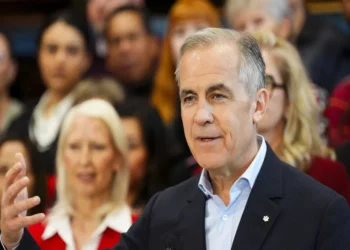WHAT’S HAPPENING TODAY: Good afternoon and happy Wednesday, readers! We are kicking off the newsletter today with the Environmental Protection Agency announcing a slew of regulations it will seek to undo, ranging from the Biden administration’s power plant emissions rules to vehicle emission standards.
EPA Administrator Lee Zeldin also announced the agency will revise the “Waters of the United States” regulation.
Welcome to Daily on Energy, written by Washington Examiner energy and environment writers Callie Patteson (@CalliePatteson) and Maydeen Merino (@MaydeenMerino). Email cpatteson@washingtonexaminer dot com or mmerino@washingtonexaminer dot com for tips, suggestions, calendar items, and anything else. If a friend sent this to you and you’d like to sign up, click here. If signing up doesn’t work, shoot us an email, and we’ll add you to our list.
EPA DEREGULATION DAY: Environmental Protection Agency administrator Lee Zeldin set the stage today to undo more than two dozen climate-related and green rules and regulations, many of which were implemented by the Biden administration.
The details: Zeldin announced this afternoon that the EPA would be initiating 31 specific actions to unleash American energy, lower the cost of living, boost the domestic auto industry, and give more power back to the states. The administrator described it as the “greatest day of deregulation our nation has seen.”
“By overhauling massive rules on the endangerment finding, the social cost of carbon and similar issues, we are driving a dagger through the heart of climate-change religion and ushering in America’s Golden Age,” Zeldin wrote in an opinion article published with the Wall Street Journal.
What’s on the chopping block: The complete list of the deregulatory actions can be found here. There are a few in particular, though, worth paying close attention to that are facing reconsideration or a complete overhaul.
- Clean Power Plan 2.0: The rules, finalized by the Biden EPA, regulated existing coal-fired and new natural gas-fired power plants operating past 2039 and required them to control around 90% of their carbon pollution.
- Mercury and Air Toxic Standards: These rules, finalized under the Biden administration, strengthened emission standards for toxic metals by 67% and finalized a 70% reduction of mercury emissions for power plants.
- The Greenhouse Gas Reporting Program: This requires large greenhouse gas emission sources, fuel and gas suppliers, and other facilities to report their emissions of greenhouse gas emissions released in production, transportation, and burning of fuels.
- EPA Vehicle Emission Standards: Under the Biden administration, the EPA finalized new emission standards for light-, medium-, and heavy-duty vehicles for model year 2027 as a way to reduce air pollution.
- The Good Neighbor Plan: Finalized by the Biden EPA, this regulation looked to reduce ozone-forming emissions from power plants and similar facilities that would drift into other states.
- 2009 Endangerment Finding: This found that six greenhouse gases (including carbon dioxide and methane) generated by human activity found in the atmosphere threaten the public health and welfare, allowing the EPA to regulate greenhouse gas emissions.
Read more from Callie and Maydeen here.
EPA ALSO LOOKS TO REVISE WOTUS: The EPA will look to redefine “Waters of the United States,” a regulation that clarifies which bodies of water are subjected to federal oversight to comply with the 2023 Supreme Court ruling in Sackett v EPA.
Former President Joe Biden’s EPA attempted to broaden the definition by including the “significant nexus” test, which helps determine which wetland or non-navigable waters are under federal protection.
However, the Supreme Court decision said WOTUS was limited to wetlands that directly adjoin rivers, lakes, and other navigable bodies of water, rejecting the “significant nexus” test. The ruling narrowed the EPA’s jurisdiction to regulate bodies of water under the Clean Water Act.
Zeldin said the agency would undergo a rulemaking process to revise the WOTUS definition that is aligned with the high court’s 2023 ruling. A federal agency’s rulemaking process is time-consuming and could take years to complete. The EPA said it would work with states who are implementing the pre-2015 WOTUS regulation to ensure compliance with the law.
BIG TECH PLEDGES TO TRIPLE NUCLEAR CAPACITY: On the sidelines of CERAWeek today, several major tech companies have signed on to a pledge to triple nuclear power capacity worldwide by 2050.
The details: Amazon, Google, Meta, and Dow, as well as oil company Occidental, were among the founding signatories of the pledge, which was coordinated by the World Nuclear Association. In signing, these companies said nuclear energy plays an important role in creating a diversified and reliable grid. They agree that nuclear capacity should at least triple by 2050 from current levels in order “to help achieve global goals for enhanced energy resiliency and security, and continuous firm clean energy supply.”
The pledge notes that nuclear power should not only provide energy for technological advancements, but for increased electrification, hydrogen production, synthetic fuels production, district heating, and more.
Some background: Nuclear energy currently generates around 9% of the world’s electricity, from roughly 439 reactors, according to the World Nuclear Association. Construction on at least nine new reactors began in 2024, with a flurry of deals on new generation and advanced nuclear also having been announced. The World Nuclear Association pointed to this ongoing trend of support for nuclear power on Wednesday, noting there is a clear path for the rapid expansion of the energy source.
“The global shift towards more nuclear highlights this is the only way we’ll deliver the abundant firm clean energy required to power growth and innovation in technology, a host of other industries and the entire economy,” said Sama Bilbao y Leon, Director General of World Nuclear Association.
Read more from Callie here.
ELECTRICITY PRICES UP IN FEBRUARY CPI REPORT: While inflation overall dipped for the year ending in February – a good sign for the Trump administration – the Bureau of Labor Statistics’s latest report found rising inflation in the category of electricity.
The details: In the most recent Consumer Price Index, the bureau revealed that the rate of price growth for electricity rose to 2.5% for the year ending in February, up from 1.9% the month before. Month-over-month, electric prices rose by around 1%, after remaining stagnant the month before. Energy services overall, including utility gas, was also up year-over-year by 3.3%, seeing a 1.4% month-to-month increase in February.
“Consumers across the country are faced with escalating electricity prices, driven by monopoly incumbent electric utilities spending on transmission. Without competition, there is no reason for them to reduce costs,” Paul Cicio, the chair of the Electricity Transmission Competition Coalition, said in a statement.
A small Trump win: While electricity prices were up, the cost of gasoline, fuel oil and energy overall appeared to be on the downward trend year-over-year – a positive sign for the administration that campaigned on lowering energy costs.
The bureau reported that energy prices including all commodities and services were down by 0.2% for the year ending in February. However, prices did jump up month-over-month by the same rate. Broken down further, gasoline prices were down for the year by 3.2% and month-over-month by 0.9%. Fuel prices similarly dropped for the year by 5.1%. However, they did increase month-over-month by 0.8%
WIND AND SOLAR GENERATED MORE ELECTRICITY THAN COAL IN 2024: Wind and solar power generated more electricity than coal last year for the first time in the United States amid growing energy demand, according to energy think tank Ember.
Ember said that, in 2024, wind and solar accounted for 17% of total electricity generation, passing coal, which dropped to 15%. Gas generation also grew by 3.3% in 2024. These energy sources helped to play a role in decreasing coal generation, which dropped to 15% last year.
Additionally, U.S. energy demand increased by 3% last year, marking the fifth-fastest rise this century. Energy demand is due to several factors, including increased electrification and the needs of data centers and AI.
Solar generation was the fastest-growing source of electricity last year, the think tank said. Solar added 64 terawatt hours of generation, more than wind, which added 32 TWh. Gas generation added 59 TWh.
The rise of batteries helped in the growth of solar generation. California installed 20% more battery capacity than solar capacity, helping transfer energy from morning to evening. Texas installed more gigawatts of solar (7.4) and battery (3.9 GW) capacity than California. However, the solar growth was inconsistent across the country. Ember said 28 states generated less than 5% of their electricity from solar last year.
CLIMATE SUPERFUND LAWS VULNERABLE TO CHALLENGES, LAWYERS WARN: As states like New York and Vermont are looking to charge large fossil fuel companies billions of dollars to support state climate superfunds, industry attorneys are warning how vulnerable these laws are to legal challenges.
A reminder: These laws implemented by New York and Vermont primarily are meant to establish and support a state fund for infrastructure projects aimed at combating, repairing, or adapting to the effects of climate change — putting the onus on fossil fuel companies, rather than the taxpayers, to supply the funds. New York specifically is looking to charge companies $75 billion over the next 25 years, starting in 2028.
The details: The Federalist Society held a panel discussion in Washington, D.C., today, featuring University of Kansas law professor Robin Kundis Craig, George Mason University law professor Donald Kochan, and environmental lawyer Jim Wedeking, on these states’ climate superfund laws. While there is some disagreement as to whether these laws are preempted by the Clean Air Act (an argument recently used in the courts to throw out related lawsuits) the panelists all agreed that these laws are vulnerable, given the way they are written.
One key issue at play is whether these laws are constitutional in challenging emissions retroactively. Craig and Kochan agreed that this is a place where these laws are vulnerable, as it questions whether an entity can be liable for an activity – that is essentially lawful – they did not have an opportunity to avoid.
While large fossil fuel companies may be responsible for contributing to rising greenhouse gas emissions, Wedeking said the laws fail to address even larger emitters: the government.
“If you look at the state of New York and take all of its municipalities together, state owned buildings, police cars, ambulances, snow plows, marine vessels, airports, hazardous waste, combustors, landfills. New York’s total GHG emissions as a group of government entities is going to dwarf about 10 biggest fossil fuel companies. But they are shielded from liability,” Wedeking said, claiming the laws go after “production” rather than “pollution.”
LARGEST E.U. GROUP RAMPS UP OPPOSITION TO COMBUSTION ENGINE BAN: The largest political group within the European Parliament, the European People’s Party (EPP), is attempting to walk back the bloc’s plans to block the sale of new combustion engine cars starting in 2035.
The details: EPP negotiator and German lawmaker Jens Gieseke told Reuters this week that the political party is looking to overturn or amend the policy in the third or fourth quarter of this year. The party is planning to propose changes like allowing for the sale of plug-in hybrid vehicles and combustion engine cars that run on biofuels past the 2035 deadline.
“It was a mistake to ban the combustion engine,” Gieseke told the outlet. “If fuels lead to a less carbon-intensive footprint, this should be recognised.”
The EPP currently holds around 188 out of 720 seats in the European Parliament. While they are the largest political group, they will need support from other parties to succeed. Gieseke told Reuters that if they can secure such support, negotiations could begin as early as April. It may not be difficult to get other lawmakers on board as individual nations, including Italy and the Czech Republic, called on the EU to adjust the rule in November.
A reminder: The EU approved the combustion engine ban in March 2023, which is expected to require all new vehicles to have zero carbon emissions starting in 2035. The law effectively bans any diesel and gas vehicles from the market. While environmentalists have praised the law as reducing vehicle emissions and helping with green goals, critics within the EU automotive industry have voiced concerns as the bloc has struggled to compete with Chinese dominance over electric vehicles.
NEW HIGHWAY CARVES THROUGH THE AMAZON RAINFOREST FOR COP23: The United Nations Climate Change Conference, also known as COP30, is set to take place in Brazil at the end of the year, but parts of the Amazon rainforest will be demolished to build a four-lane highway for the upcoming conference.
The BBC reports that a four-lane highway will cut through tens of thousands of acres of the Amazon rainforest to help ease traffic brought by the climate conference. The Brazilian city of Belém is expected to host more than 50,000 people, the outlet said.
The Amazon plays a key role in absorbing global carbon emission and is home to a range of wildlife. BBC said that machines and diggers are paving the road over protected areas.
The state government had touted the idea of the highway since 2012 but received pushback due to environmental concerns. Now, several infrastructure projects have been approved for the COP summit, BBC said.
RUNDOWN
Canary Media California’s utility bill crisis is clear to all. The solution, not so much.
E&E News CERAWeek: Trump trade war has Canada rethinking its energy future
Inside Climate News ‘Weathering’ Expert Arline Geronimus Reflects on Climate Change and Health Inequities
New York Times Climate Group Funded by Bill Gates Slashes Staff in Major Retreat















